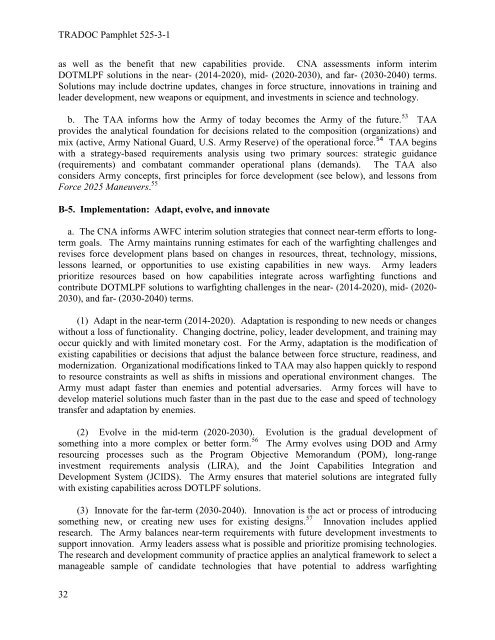TP525-3-1
TP525-3-1
TP525-3-1
You also want an ePaper? Increase the reach of your titles
YUMPU automatically turns print PDFs into web optimized ePapers that Google loves.
TRADOC Pamphlet 525-3-1<br />
as well as the benefit that new capabilities provide. CNA assessments inform interim<br />
DOTMLPF solutions in the near- (2014-2020), mid- (2020-2030), and far- (2030-2040) terms.<br />
Solutions may include doctrine updates, changes in force structure, innovations in training and<br />
leader development, new weapons or equipment, and investments in science and technology.<br />
b. The TAA informs how the Army of today becomes the Army of the future. 53 TAA<br />
provides the analytical foundation for decisions related to the composition (organizations) and<br />
mix (active, Army National Guard, U.S. Army Reserve) of the operational force. 54 TAA begins<br />
with a strategy-based requirements analysis using two primary sources: strategic guidance<br />
(requirements) and combatant commander operational plans (demands). The TAA also<br />
considers Army concepts, first principles for force development (see below), and lessons from<br />
Force 2025 Maneuvers. 55<br />
B-5. Implementation: Adapt, evolve, and innovate<br />
a. The CNA informs AWFC interim solution strategies that connect near-term efforts to longterm<br />
goals. The Army maintains running estimates for each of the warfighting challenges and<br />
revises force development plans based on changes in resources, threat, technology, missions,<br />
lessons learned, or opportunities to use existing capabilities in new ways. Army leaders<br />
prioritize resources based on how capabilities integrate across warfighting functions and<br />
contribute DOTMLPF solutions to warfighting challenges in the near- (2014-2020), mid- (2020-<br />
2030), and far- (2030-2040) terms.<br />
(1) Adapt in the near-term (2014-2020). Adaptation is responding to new needs or changes<br />
without a loss of functionality. Changing doctrine, policy, leader development, and training may<br />
occur quickly and with limited monetary cost. For the Army, adaptation is the modification of<br />
existing capabilities or decisions that adjust the balance between force structure, readiness, and<br />
modernization. Organizational modifications linked to TAA may also happen quickly to respond<br />
to resource constraints as well as shifts in missions and operational environment changes. The<br />
Army must adapt faster than enemies and potential adversaries. Army forces will have to<br />
develop materiel solutions much faster than in the past due to the ease and speed of technology<br />
transfer and adaptation by enemies.<br />
(2) Evolve in the mid-term (2020-2030). Evolution is the gradual development of<br />
something into a more complex or better form. 56 The Army evolves using DOD and Army<br />
resourcing processes such as the Program Objective Memorandum (POM), long-range<br />
investment requirements analysis (LIRA), and the Joint Capabilities Integration and<br />
Development System (JCIDS). The Army ensures that materiel solutions are integrated fully<br />
with existing capabilities across DOTLPF solutions.<br />
(3) Innovate for the far-term (2030-2040). Innovation is the act or process of introducing<br />
something new, or creating new uses for existing designs. 57 Innovation includes applied<br />
research. The Army balances near-term requirements with future development investments to<br />
support innovation. Army leaders assess what is possible and prioritize promising technologies.<br />
The research and development community of practice applies an analytical framework to select a<br />
manageable sample of candidate technologies that have potential to address warfighting<br />
32


